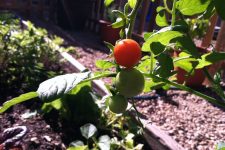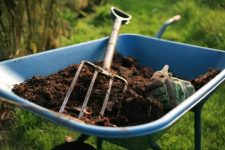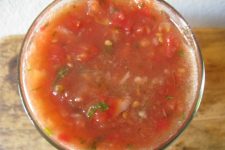
Let’s be honest — with the high level of urbanization in our world, growing seasonal fruits and vegetables just isn’t feasible for everyone. But the good news is…during the peak of harvest there are multiple ways to acquire fresh, home-grown produce without having to step foot in a grocery store or break the bank!
Growing your own vegetable garden and buying produce at the store aren’t the only ways to acquire fresh foods.
Be encouraged, there are many ways to get fresh fruits and veggies into your kitchen and on you plate.
Keep your eyes open for roadside stands. Granted these vary based on location and geography, and they tend to populate the roads more heavily when it gets later in the summer, or into early fall, but roadside stands are a great way to enjoy fresh, local produce without having to grow it yourself. Bonus: If you find something really great, take the foods home, and then plan your meals for the next week around them!
Farmers markets. Farmer’s markets are a great place for food shopping and networking! Meet the farmers face-to-face, learn what grows in your area, and find a trusted food source. Note: In case you’re interested, here’s my best money-saving farmer’s market tip…go near the end of the advertised market hours. I have had the best luck gleaning the leftovers for a fraction of the price. Farmers are often looking to un-load their remaining stock and they are much more willing to drop the price in order to make a sale.
Make friends with an avid gardener. Those who grow a large garden each year always seem to grow a surplus, just in case. If you know someone who gardens faithfully, offer to help in the garden or barter in exchange for produce. Many home gardeners are very happy to have the help and are very likewise willing to share the surplus.
Share a garden with someone else. If lack of space is your issue, consider an arrangement where someone else — a friend or family member — who has space for a garden and you share resources and efforts. For example, you could plant a garden in a friend’s backyard and then spend a preset amount of time each week working to cultivate and care for it with your friend. In the end you both would split the harvest.
‘
Network with your local Slow Food chapter. As their website defines it, “Slow Food is an idea, a way of living and a way of eating. It is part of a global, grassroots movement with thousands of members in over 150 countries, which links the pleasure of food with a commitment to community and the environment.” Click here to find your local chapter and get connected with like-minded others who can better help you source local, fresh-grown foods.
Eat and buy in season. There are crop calendars for every state and zip code that tell you what is available and in season throughout the year. Check it out and then gear your fresh produce purchases surrounding those foods.
Join a co-op or CSA (Community Support Agriculture) program. So you’re learning to eat in season and you’re willing to be flexible, a farmer’s co-op, or CSA, can offer a great alternative to growing your own. In our area, most CSA’s involve receiving a box of whatever the farm is producing that week…that often makes it unpredictable, both in terms of the actual amount of food you end up with and the exact items you get. My CSA farmer functions on a “farm share” basis. So basically we pay per farm share and then shop directly at the farm, or at other markets throughout the week, and buy our produce — as little or as much as needed each week — until the share runs out.
Replace landscape plants with edibles. If your time and space is limited, you could maximize outdoor areas and put in decorative borders full of herbs, rainbow Swiss chard and striking cayenne pepper plants. And instead of the short-lived color of azaleas in the spring, grow blueberries that are decorative year-round. The possibilities are endless and edible landscapes aren’t just pretty — they provide highly-nutritious fruits and veggies that can save you money.
Forage. Wild edibles can be found nearly everywhere. Not to far from the “suburban oasis” and chemical lawns, our homes are often times surrounded by groceries — free for the pickin’. From dandelions, wild strawberries, blackberries, and violets, to plantain, clover, and sorrel I encourage you to learn how to identify the food that grows naturally in your area!
“U-Pick” Farms. Making a trip to a “u-pick” farm can be a super fun family activity — and budget-friendly too. For example, there’s an apple orchard near us that allows for the droppings to be sold at an extremely discounted rate. And we often find that strawberries picked by the pint are significantly cheaper than those that are pre-packaged. Click here to search for “u-pick” farms in your area.
Grow a few plants in containers. Growing fruits and vegetables in the ground and keeping a traditional garden may not be an option for several reasons — a lack of backyard space, pets, or homeowner association rules — but growing a few plants in containers or small pots on your porch, patio, or fire escape could provide a workable solution. Be sure to grow the most profitable plants in order to save yourself the most money for your efforts. Read more about growing in small spaces here…
What about you! Are you able to grow a garden? If not, what alternatives do you have for acquiring fresh fruits and vegetables?




 A Recipe for Homemade Itch Relief Stick
A Recipe for Homemade Itch Relief Stick
Great Post! Thanks. Love the link to localharvest.org … surely, that will prove invaluable. Who knew? Yes, we do/will have a garden this year, but it won’t support some of the produce I want … like sweet corn. Not enough space to do it right and get a decent crop. It is just a small backyard garden in the city. So it helps, but it doesn’t supply the variety we need. Also loved the idea of replacing landscaping with decorative edibles. Hubby may not like it so much (cause of the added work) but I think I will have to pursue that idea. Problem is that our front yard landscaping is shaded most of the day. What edibles are also shade lovers? I need to find out. Thanks again for a great post. Peg
Hi Peg, I had a hubby like that but you have to be a bit devious! Interplanting food crops, beneficial plants like medicinals and herbs is easier than you think – I just tell my man the role they’ll play in our landscape and it’s no issue. An example is if you need a ground cover (say for a semi-shaded area), add some fragrant herbs like thyme or oregano that create a living carpet + give you a culinary benefit.Choose plants that are multi-functional & do double-duty! Tall & skinny edibles like shallots, chives, onions & garlic can be squeezed into tiny spaces in between ornamentals in sunny spots. I grow spinach, chard, lettuce, leeks, chervil, mint, nasturtiums (edible flowers/eaves for salads etc), sweet potato (fantastic ground cover) and parsley all in semi shaded spots. Aloe vera is both a striking architectural plant but provides you with medicinal uses for burns, skin problems etc. These are just a few suggestions – more ideas @ http://themicrogardener.com/fast-food-diy-instant-veggie-garden-part-2/. Good luck with your garden. Anne
At the beginning of the year I had my husband take out a long row of hedges in our backyard and make a raised bed for me. Its not your typical raised bed at 2 feet deep and 31 feet long :o) but I ended up with 64 square feet of gardening space. I’ve been pleasantly surprised at what I can fit in there. Now I’m so motivated to grow I find myself sticking plants everywhere! Our farmers markets around here are more for trend and not so much local food. Its basically the same food from grocery stores for the same price….just a cooler way to shop. I am checking into to joining 1 of 4 CSA’s we have close by. We also have 2 chickens. They live in the garage since we are technically supposed to have them. They enjoy walking through the house to go forage in the backyard every day. :o) Thanks for all that you do……I truly love your blog!!! Its been a big inspiration for me to do the things I’ve always had a passion for.
Any recommendation for plants that grow in 100% shade? My apartment doesn’t have a patio or balcony and I am not allowed to have anything in my windows. Even if I did, my only two windows don’t get any sun the hours I am home anyway.
Have you considered buying some sort of grow light, or an aerogarden? Then you can grown herbs, lettuces, and vegetables year round inside. Or google shade vegetables for your region and see what is available.
You Grow Girl has a post on Building a DIY Lighting System as Stacy says, this might be a solution. http://www.yougrowgirl.com/2011/02/03/build-a-d-i-y-lighting-system/.
Jordyne–Sprouts prefer low light. I bought some sprouting trays–nice, but not necessary–and grow them on my kitchen counter. It just looks like a random Tupperware type container.
I’m really limited by rental rules–always get it in writing if someone OKs a garden, from experience. I put one in and had to rip it out. I would do containers, but don’t want to buy soil & have to move everything when I do move–esp if I find something once the plants get going.
In addition to the sprouts, I grow microgreens & basil. I haven’t tried it yet, but baby spinach might do OK on a counter that gets some sun. (And hence you’re not growing “in your window)
You could always repurpose one of the clamshells it is sold in. Easy enough to throw a dishtowel over it if someone comes in. 😉
Also, some flowers like nasturtiums are edible. (Check carefully to make sure the ones you plant are designed for consumption.) You could probably sneak these past the kind of ding-a-ling who is opposed to “gardening.” “oh, these? They were an Easter present. Aren’t they pretty? 😉
My primary plan aside from moving to a place where I can grow my own, is to join a CSA and continue buying from local farms.
We actually have 2 1/2 acres of land but our property is so heavily shaded that the plants just cannot produce. Cutting down trees would not help as all of the other property around us is equally shady and it shades our property too. However our utility bills are lower in the summer because we are not sitting in the full sun and our yard is shady and cool so that we can enjoy being outside in the summer.
I live in northern NJ in a fairly light suburban area, most homes have at least some yard and there are farms not too far from us,I buy my eggs from one of them. Unfortunately the ground here is so contaminated from the industry of years past that large chunks of land within the 20 mile radius surrounding me are considered Superfund sites and regulated by the fed govt. My husband’s work is on one of them. In lieu of replacing large portions of so in my yard, and we rent so I wouldn’t reap long-term benefits from it, I try to frequent the farmers market, which is good, and stay local when possible. I am blessed since our farmers market is open from mid June to the end of march.
Ann
We love our U-Pick farms! We are lucky too because while all are not certified organic, they all follow organic-like practices in their growing. We do a lot of our own veggies, but many fruits need more space and are more permanent (so we can’t succession plant as easily), so with our limited space, they are hard to do ourselves. We used to just go get what we could eat at the time, but then we discovered we could buy “seconds” by the bushel for half price. We usually go pick what we want to consume right now, and then buy a few bushels of seconds from them that we bring home and can to save for later (nothing like pulling out a can of “fresh” peaches in the dead of winter, yum!). We are big fruit eaters so this saves us a bundle and we are eating fresh and organic food year round.
When I first got married we lived in a town house and I gardened on our little patio. I was able to grow tomatoes, basil and many other plants. I did have little patch of dirt but most was grown in containers. I was lucky because our leasing company encouraged gardening. They even had contests each year for the best ‘gardens”.
Thank you for all of the wonderful information. My family and I are moving out of state this summer. We won’t be able to plant a garden this year. Found several u-pick locations close to our new home. Can’t wait!
We manage to grow a decent amount on our teeny little 33×100 foot urban lot. Obviously our house takes up a good deal of the lot 🙂 but we’re lucky that the back yard has Southern exposure. We have a few raised beds and some planters on the deck and patio. I manage to find a way to squeeze in a bit more each year! We’re hoping to add some fruit trees soon, too. We may try growing some espalier to save space but I still need to do more research on that before I decide.
Some other options for those in very urban areas: 1. Rent a plot in a community garden. My city has more and more community gardens forming every year and for a decent amount of people there is one within walking distance of their home. 2. See if there is a free produce cooperative in your area – they are springing up in more and more cities. These groups allow backyard gardeners to swap their surplus with each other. It allows people to get much more variety of fresh local produce than they would be able to grow on their own. I started a group in my neighbourhood last year and it got off to a pretty good start – we had everything from Swiss chard and raspberries to a wide variety of tomatoes and sugar pumpkins. If you want an idea of how the group is run you can go here: http://westhamiltonproducecooperative.blogspot.ca/
Some other ideas when you don’t have space or a garden are:
* Try a Mushroom Kit – these are quite economical and if you love mushrooms you can grow several flushes indoors without any special equipment or skills.
* Re-grow new food from old: Stick the roots from your shallots/spring/green onions into water after cutting the tops off and they will reshoot many times over if you refresh the water in the glass daily. They are great value greens that provide you with plenty of fresh flavour.
* Join a local permaculture or transition town group – many people swap/share their surplus produce for free or at very low cost to help others in the community. It’s a great way to pick up locally grown seeds and plant material + knowledge and network with like-minded others. We have a freebies table at our groups and enjoy the give and take nature of this system.
I need to change your title to, “What Should I Do If I Can’t Find a Solution?”… for it seems that every single one of your articles answers this question. Each question or problem focuses on a single aspect of living. Every answer offers an entire landscape of possibilities. Truly enjoyable. Thanks.
Have you ever heard of bountifulbaskets.org? I’ve done it a few weeks, and it’s a lot of fun.
You can grow sprouts in a jar too! That’s a great way to get some very healthy food any time of year!
http://purposelyfrugal.com/2011/06/13/961/#.T8rd1ESlLM0
Great beat ! I would like to apprentice while you amend your site,
how could i subscribe for a blog web site? The account helped me
a acceptable deal. I had been tiny bit acquainted of
this your broadcast offered bright clear idea
Every idea is awesome. This is not only for those who don’t have garden space but for those who aren’t sure a garden is for them.